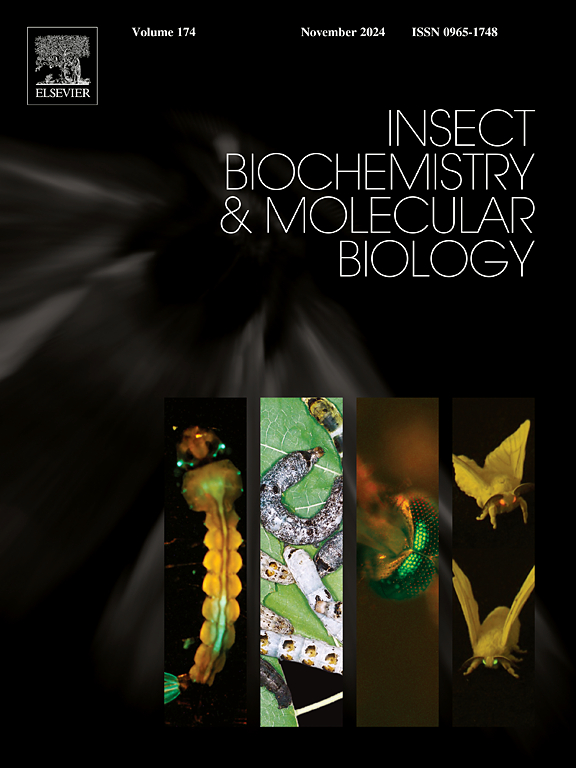Calcofluor disrupts binding of Bt toxin Cry1Ac to midgut receptors in Trichoplusia ni
IF 3.7
2区 农林科学
Q2 BIOCHEMISTRY & MOLECULAR BIOLOGY
引用次数: 0
Abstract
The parasporal crystal proteins (Cry proteins) from the soil bacterium Bacillus thuringiensis (Bt) are major insecticidal toxins in formulated Bt sprays and in current transgenic Bt crops widely used in agriculture. To understand the modes of action of Cry proteins and mechanisms of Cry resistance in insects, it is important to understand the specific interaction of Cry proteins with the specific receptors in the insect midgut. Previous studies have found that the fluorescent brightener Calcofluor could significantly reduce the insecticidal activity of Cry1Ac in the cabbage looper, Trichoplusia ni. In this study, the effects of Calcofluor in T. ni larvae on the structure of the midgut, the composition and abundance of midgut brush border membrane proteins, and the binding of midgut brush border membranes with Cry1Ac were examined. Finally, the inhibiting activity of Calcofluor on the binding of Cry1Ac to midgut binding sites was determined. The results from this study indicated that Calcofluor blocks the binding of Cry1Ac to the midgut binding sites by competitively binding the carbohydrate moieties that are involved in the specific binding of Cry1Ac to the midgut, which consequently inhibits the toxicity of Cry1Ac in larvae. Therefore, this study revealed that carbohydrate moieties on insect midgut brush border membranes play crucially important roles in the functional specific binding of Cry1Ac to the midgut receptors in the pathway of toxicity.

钙氟破坏毛癣菌Bt毒素Cry1Ac与中肠受体的结合
苏云金芽孢杆菌(Bacillus thuringiensis, Bt)的拟孢晶体蛋白(Cry蛋白)是配方Bt喷剂和目前广泛应用于农业的转基因Bt作物中的主要杀虫毒素。为了了解Cry蛋白的作用方式和昆虫的抗哭机制,了解Cry蛋白与昆虫中肠中特定受体的特异性相互作用是很重要的。先前的研究发现,荧光增白剂Calcofluor可以显著降低白菜环虫Trichoplusia ni中Cry1Ac的杀虫活性。本研究考察了钙氟对褐飞虱幼虫中肠结构、中肠刷缘膜蛋白组成和丰度以及中肠刷缘膜与Cry1Ac结合的影响。最后,测定了Calcofluor对Cry1Ac与中肠结合位点结合的抑制活性。本研究结果表明,Calcofluor通过竞争性地结合参与Cry1Ac与中肠特异性结合的碳水化合物部分,阻断Cry1Ac与中肠结合位点的结合,从而抑制Cry1Ac对幼虫的毒性。因此,本研究揭示了昆虫中肠刷状缘膜上的碳水化合物部分在Cry1Ac与中肠受体的毒性途径的功能特异性结合中起着至关重要的作用。
本文章由计算机程序翻译,如有差异,请以英文原文为准。
求助全文
约1分钟内获得全文
求助全文
来源期刊
CiteScore
7.40
自引率
5.30%
发文量
105
审稿时长
40 days
期刊介绍:
This international journal publishes original contributions and mini-reviews in the fields of insect biochemistry and insect molecular biology. Main areas of interest are neurochemistry, hormone and pheromone biochemistry, enzymes and metabolism, hormone action and gene regulation, gene characterization and structure, pharmacology, immunology and cell and tissue culture. Papers on the biochemistry and molecular biology of other groups of arthropods are published if of general interest to the readership. Technique papers will be considered for publication if they significantly advance the field of insect biochemistry and molecular biology in the opinion of the Editors and Editorial Board.

 求助内容:
求助内容: 应助结果提醒方式:
应助结果提醒方式:


